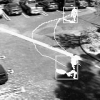Free Online Productivity Tools
i2Speak
i2Symbol
i2OCR
iTex2Img
iWeb2Print
iWeb2Shot
i2Type
iPdf2Split
iPdf2Merge
i2Bopomofo
i2Arabic
i2Style
i2Image
i2PDF
iLatex2Rtf
Sci2ools
CVPR
2000
IEEE
2000
IEEE
Representation and Optimal Recognition of Human Activities
Towards the goal of realizing a generic automatichuman activity recognition system, a new formalism is proposed. Activities are described by a chained hierarchical representation using three type of entities: image features, mobile object properties and scenarios. Taking image features of tracked moving regions from an image sequence as input, mobile object properties are first computed by specific methods while noise is suppressed by statistical methods. Scenarios are recognized from mobile object properties based on Bayesian analysis. A sequential occurrence several scenarios are recognized by an algorithm using a probabilistic finite-state automaton (a variant of structured HMM). The demonstration of the optimalityof these recognition method is discussed. Finally, the validityandthe effectiveness of our approach is demonstrated on both real-world and perturbed data.
Activity Recognition System | Computer Vision | CVPR 2000 | Image Features | Mobile Object Properties | Probabilistic Finite-state Automaton | Structured Hmm |
| Added | 12 Oct 2009 |
| Updated | 30 Oct 2009 |
| Type | Conference |
| Year | 2000 |
| Where | CVPR |
| Authors | François Brémond, Ramakant Nevatia, Somboon Hongeng |
Comments (0)

